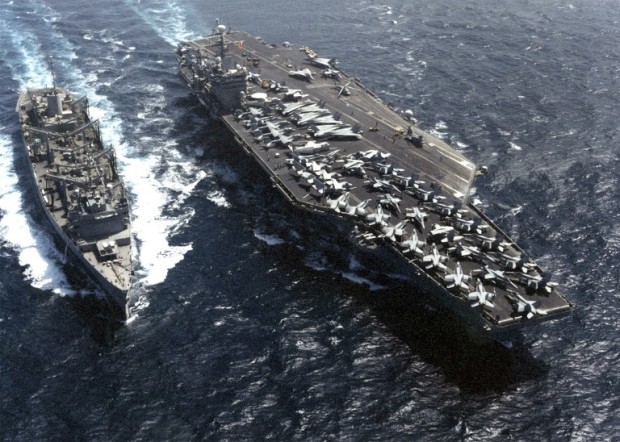
In this photo released 13 October 2001 by the US Navy, the aircraft carrier USS Carl Vinson (right) and the fast combat support ship USS Sacramento steam side-by-side during a routine replenishment at sea. The Carl Vinson is leading a naval strike group moving toward the Korean Peninsula on Saturday as the United States boosts its defenses against North Korea’s nuclear ambitions. AFP
WASHINGTON — A US Navy carrier strike group was moving toward the Korean Peninsula on Saturday as the United States boosts its defenses against North Korea’s nuclear ambitions.
“US Pacific Command ordered the Carl Vinson Strike Group north as a prudent measure to maintain readiness and presence in the Western Pacific,” said Commander Dave Benham, spokesman at US Pacific Command.
“The number one threat in the region continues to be North Korea, due to its reckless, irresponsible and destabilizing program of missile tests and pursuit of a nuclear weapons capability,” he told AFP.
READ: US strikes on Syria justify nukes — North Korea state media
The strike group includes the Nimitz-class aircraft supercarrier USS Carl Vinson, a carrier air wing, two guided-missile destroyers and a guided-missile cruiser.
Originally scheduled to make port calls in Australia, it headed instead from Singapore to the Western Pacific Ocean.
The North has carried out five nuclear tests — two of them last year — and expert satellite imagery analysis suggests it could well be preparing for a sixth.
US intelligence officials say Pyongyang could be less than two years away from developing a nuclear warhead that could reach the continental United States.
On Thursday and Friday, US President Donald Trump hosted his Chinese counterpart Xi Jinping for talks during which he pressed Pyongyang’s key ally to help curb the North’s nuclear weapons program.
Trump has threatened unilateral action against the hermit state, a threat that appears more palpable after he ordered a strike on a Syrian airfield following an apparent chemical attack.
The head of North American Aerospace Defense Command (NORAD), which provides missile detection and defense for the region, said Thursday she was “extremely confident” of US capability to intercept a potential intercontinental ballistic missile (ICBM) bound for America from the North.
But General Lori Robinson expressed concerns for the type of ballistic missile powered by a solid-fuel engine that Pyongyang said it successfully tested in February.
“Amidst an unprecedented pace of North Korean strategic weapons testing, our ability to provide actionable warning continues to diminish,” Robinson said in written testimony to senators. CBB/rga